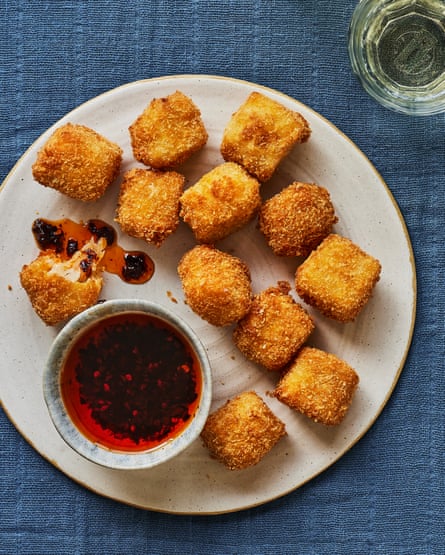Our restaurant Bao turns 10 this year, and today’s two dishes capture what’s driven us from the start: heritage and innovation. As the season shifts towards autumn, we crave deeper, more grounding flavours, and lu rou fan is just that: rich, savoury and nostalgic. The daikon tots, meanwhile, are a happy kitchen accident from even before we even had a restaurant – they’re crunchy on the outside, soft within and oddly satisfying. Both dishes reflect what we have always been about: balancing the familiar and the unexpected. Honest, humble and a little indulgent, and perfect for that in-between time as summer fades.
Lu rou fan (Taiwanese braised pork, pictured top)
This involves a two-stage cooking process. The pork is gently poached twice, to make it tender, and it’s then braised in flavoured water, so it soaks everything up and ends up really moist.
Prep 15 min
Cool 4 hr+
Cook 3 hr
Serves 4
For the poached pork
500g pork belly
10ml michiu (rice wine), or cooking sake
2cm piece fresh ginger, bashed with the flat of a knife
½ garlic clove, crushed
For the braise
¼ tbsp rapeseed oil
¼ shallot, diced
1 tbsp light soy sauce
1 dried red chilli
1 star anise
1½ tsp Shaoxing rice wine
¾ tsp mirin
1 garlic clove, peeled and crushed
¼ red apple, peeled, cored and diced
1cm piece fresh ginger, bashed with the flat of a knife
¼ spring onion, cut in half lengthways
¾ tsp rice vinegar
1 small cinnamon stick
¼ tsp dark soy sauce
Steamed rice, to serve
First, poach the pork. Put the pork belly in a deep pan filled with cold water, bring to a boil and cook for five minutes. Lift out the pork and discard the water.
Put the pork skin side down in a clean pan, add enough cold water just to cover, then add the rice wine, ginger and garlic. Bring to a boil, then turn down the heat and poach for about 20 minutes, until the pork is firm, no longer pink and the skin looks translucent. Take off the heat and leave the pork to cool in its poaching liquid for at least four hours, and ideally overnight, covered and in the fridge.
When you’re ready to braise, lift the pork out of the poaching liquor and cut it into cubes, skin and all. Strain the poaching liquor and reserve.
Now to braise the pork. Put the oil in a casserole for which you have a lid (we use a traditional clay pot) on a medium heat. Add the diced shallot and cubed pork and fry gently, stirring often, for about 10 minutes, until the shallot softens. Pour in 125ml of the reserved poaching liquid and all the remaining braise ingredients except the dark soy sauce, and bring to a boil. Turn down the heat to a simmer, cover and braise for two hours, topping up with poaching liquid if needed.
Lift off the lid, stir in the dark soy sauce, turn up the heat to medium and cook for another 20 minutes, until the sauce reduces and turns glossy and slightly sticky.
Serve on steamed rice – the fatty nature of the sauce coats the grains perfectly. The trick is not to render the fat too much, so the pork melts in the mouth, but still holds its form.
Daikon tots

You’ll need to start on these a day ahead.
Prep 5 min
Freeze Overnight
Cook 40 min
Makes 10–12
850g daikon (ie, 1 large one), peeled and coarsely grated
90g plain flour, plus about 100g extra for coating
1⅓ tsp salt
2 eggs, beaten
200g panko breadcrumbs
About 500ml vegetable oil, for deep-frying
The day before you want to eat, put the grated daikon in a large, dry frying pan on a medium heat and cook for about 15 minutes, until most of the moisture is gone. Add up to 100ml cold water, so you have a 1:3 liquid-to-daikon ratio, turn down the heat to low, then stir in the 90g flour and the salt until well combined.
Line a small baking tin with clingfilm, then press in the daikon so it’s an even 2½cm deep. Put the tin in a steamer, and steam over a medium heat for 30 minutes (keep an eye on the water level in the base, so it doesn’t boil dry). Lift out the tin, leave to cool completely, then wrap up the tin tightly and freeze overnight.
The next day, take the daikon tin out of the freezer and let it sit at room temperature for about 10 minutes, just until it’s soft enough to cut. Unwrap the tin, lift out the block of daikon and cut it into 2½cm cubes – these are your tots.
Set up a breading station with the remaining 100g flour, beaten eggs and panko in separate shallow dishes. Coat each tot first in flour, dip it in the egg (left hand), then into the panko (right hand; using alternate hands helps keep the crumbs from clumping).
Heat the oil – enough to cover the tots – in a deep, heavy pan to 160C (or until a cube of ginger sizzles and browns in 20 seconds). Fry the tots in batches for two minutes each, turning them gently so they get an even colour all over, then lift out on to paper towels and leave to cool completely.
Turn up the heat a little and bring the oil to 190C (or until a cube of ginger sizzles and browns in just 10 seconds). Fry the tots a second time, again in batches and this time for about a minute in total, just until golden and crisp – the double fry gives them a light, crunchy crust and a soft, gooey centre. Drain well and serve hot with your favourite dipping sauce; I like mine with hot sauce or chilli oil.
-
Erchen Chang is chef/co-founder of Bao in London

 3 months ago
64
3 months ago
64

















































